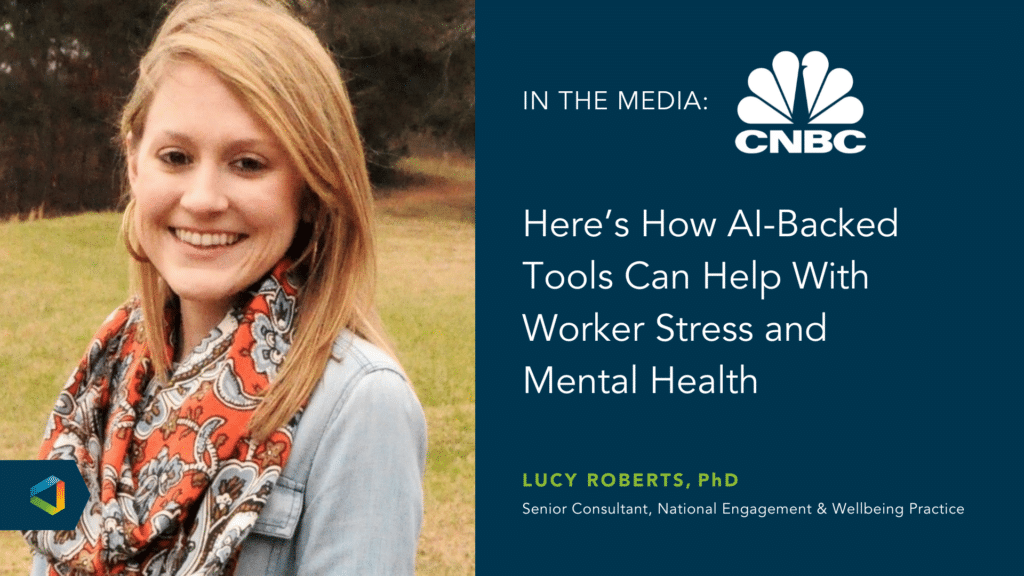Healthy People
Policies Alone Won’t Keep Your Employees…But a Supportive Environment Will
Policies Alone Won’t Keep Your Employees…But a Supportive Environment Will
Over the last few years, we’ve seen companies across industries pivot to adopt programs and offer resources to support the increasing mental health, financial and physical health challenges employees are facing, problems exacerbated by the pandemic.
Yet, too often these programs fail to address one significant source of strain and a common blind spot for leaders: a high-pressure work environment and culture of stress. Further, many employers falsely believe that stress and pressure yield better results. But as the mounting evidence suggests, health care expenditures are nearly 50% greater than at other organizations and 550 million workdays are lost each year due to stress on the job not to mention an increase of almost 50% in voluntary turnover.
When it comes to addressing these problems head-on, programs and policies implemented without an intentional plan to shift the culture, are merely a band aid. With more than 50% of remote workers considering quitting their job before returning to the physical workplace, it’s essential for leaders to get clear about prioritizing organizational change that reflects what their people actually want and need.
Whether within physical or virtual walls, studies show that visible and well-communicated support can be the undercurrent that stems the tide in your favor, both attracting new workers and helping to retain valuable colleagues. In its most basic form, support is simply a foundation of cultural resources and behaviors that promote total wellbeing and empower both individual and organizational performance. More than policies and benefit designs alone, true support is a result of training, communicating and demonstrating assistance with a consistent and multi-faceted approach.
What might this look like in YOUR organization?
Promote Opportunities to Build Resiliency
On-going training to build and enhance resiliency demonstrates a commitment to individual mental wellbeing that can positively impact business objectives.
Defined as the ability to “bounce back,” resiliency allows workers to recover (and do their best work) from stressors (i.e., a long-term pandemic), a business interruption (i.e., decreased sales) or a personal health issue (i.e., unexpected illness). For example, prior to the pandemic, organizations that had the importance of resilience and agility, by providing training, had an advantage. They were able to adapt quickly to changed conditions.
Take Action:
- Develop a schedule of in-house trainings or vendor presentations, showcase and communicate leadership modeling to illustrate a commitment from the top down. Work to build organizational and individual resiliency plans to assist middle management in supporting their teams (and themselves).
- Examine your existing business model through a fresh lens to illuminate new options and possible adjustments to the status quo. Gallop’s recent Global Workplace Report states “leaders must recognize the influence of employee wellbeing and engagement on workforce resilience.” Kathy Gardner, remote work expert at FlexJobs, adds “Over the last year, companies have experienced what remote work can do for their business strategy, their operations and their employees. Employers should absolutely evaluate their workforce post-pandemic with open eyes about what an effective business model could look like for them.”
Prioritize Deep Listening Skills
Across your organization, prioritize discussion and training that develops active and mindful listening skills. Nowhere is this more important than in a hybrid or remote environment, where body language and in-person cues can be lost.
Effective communication is important to both business and cultural goals. Listening can be overlooked as a support tool, because it relies on non-verbal communication- and emotional intelligence. Executive Coach, Naz Beheshti, reminds us that research tells us that people think a lot faster than people talk, so we often formulate our response before someone stops talking. Active listening tells us to put the pause on response, while seeking to understand.
Take Action:
- Deep Listening takes Active Listening a step further, by trying to understand without judgement. In a supportive environment, deep listening can invite discovery and empathy and contribute greatly to inclusion and belonging. Bring deep listening skills to life by forming an employee resource group that pilots a series of virtual or in-person challenges. Use Active Listening exercises as “ice-breakers” before department or all-employee meetings, sales trainings, etc. to create opportunities to practice skills.
- Add a bullet to department or supervisory meetings that illustrate components or “homework” for colleagues to try with family members/friends and provide feedback on outcomes. Don’t forget to use a quick 1-3 question survey, before and after, to gauge outcomes and engagement.
Understand Work Life Integration vs. Balance
By differentiating between integration and balance, you will support your workforce with an important distinction. Integration is key to supporting mental wellbeing, inclusive policies, and healthy relationships (both at work and home), by allowing for the ebb and flow of individual situations and experience. True Balance is rarely achievable, while Integration accepts, encourages, and allows for fluctuating priorities within personal and professional lives.
Employees, as evidenced by the Great Resignation, are raising their voices over unbalanced work environments. Virtual options allowed us to whether the Pandemic storm, working from anywhere, at any time. However, with no boundaries, the options to work 24/7 was freeing for some and overwhelming for many.
Take Action:
- According to one study, employees want flexibility and options from employers moving forward, noting that 64% of employees would prefer a permanent work-from-home situation over a $30K pay raise. HR Leaders should evaluate hybrid workforce policies and train managers to hybrid teams as a key will be key for attracting and retaining talent.
- Work Life Integration can support employees by exhibiting mutual respect for both on and off the job responsibilities. Schedule a regular cadence of “Coaching” sessions to allow both employer and employee to voice concerns, discuss priorities and revamp job descriptions to communicate purpose and value.
- Even when tested in the most extreme situation (Covid-19), organizations found the remote work was a viable option and employees performed beyond most expectations, according to Kathy Gardner at FlexJobs. Can your company adopt any permanent options as a result of these new insights?
- Examine your social media presence, communications, and management “norms”. For example, are emails after hours viewed as acceptable? Are unnecessary meetings jamming calendars and reducing effective work? Do social media posts illustrate the culture that you intend to promote? Poll your employees and leadership teams for their input and perspective and then update communications.
Studies show that employees who do not feel supported will not stay with their current employer. Thus, it’s not just what support is (as defined by policies), but how it’s demonstrated (modeling and culture), that should become a key business objective. Jim Harter, Chief Scientist of Workplace and Wellbeing at Gallup, states “matching what employers and workers want going forward is essential, because work will never be the same again.”
Employers, this may be new or different territory for your leadership and culture, but it’s an exciting opportunity to support your workforce with a more human approach. Don’t be afraid to ask your employees, your teams and yourself…are we doing the best we can to support our people?"




